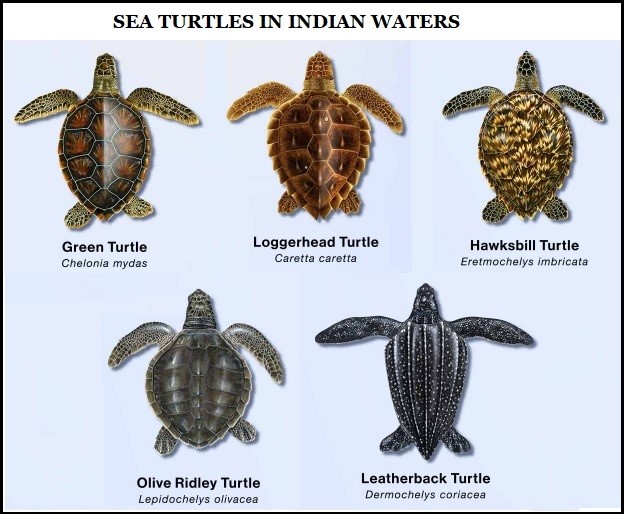What is the issue?
The rising death toll of sea turtles call for integrated conservation measures to protect the protectors of marine ecosystem.
How diverse are sea turtles in India?
- There are five species of sea turtles in Indian waters:
- Leatherback
- Loggerhead
- Hawksbill
- Green
- Olive Ridley

- The turtle breeding season is usually between November and December.
- E.g. Olive Ridley nests between December and April along the Chennai-Kancheepuram coastline in Tamil Nadu.
- The eastern coastline is the feeding area for Olive Ridley, juvenile Hawksbills and Green turtles.
- Off-shore waters are also migratory routes for the Olive Ridley while moving towards beaches in Andhra Pradesh and Odisha.
What is the significance?
- Sea turtles, especially the leatherback, keep jellyfish under control.
- This in turn helps maintain healthy fish stocks in the oceans.
- The Green turtle feeds on sea grass beds.
- Turtle populations could improve seagrass ecosystem health by removing seagrass biomass and preventing sediment formation.
- By cropping the grass, they provide a nursery for numerous species of fish, shellfish and crustaceans.
- The Hawksbill feeds on sponges in the coral reef ecosystem and opens up crevices for other marine life to live in.
- Turtles are also transporters of nutrients and energy to coastal areas.
- Unhatched eggs, eggshells and fluids help foster decomposers and create much needed fertilizer in sandy beaches.
What are the threats?
- In India, sea turtles are protected under the Indian Wildlife Protection Act of 1972, under the Schedule I Part II.
- Despite this legal protection they face grave threats.
- Bycatch is one such example, which is the name given to ocean animals that are unintentionally caught by fishing gear.
- Notably, high number of dead turtles washing up ashore is recorded each year.
- Thousands of sea turtles are accidentally captured, injured or killed.
- The mechanised boats, trawl nets and gill nets operated and used by commercial fishermen are the major causes.
- The heavy toll of injuries and deaths occurs when turtles begin migrating.
- It could be to their nesting grounds on beaches or fishing areas that are their feeding grounds.
How are the protective measures working?
- Limits - Under current regulations, mechanised trawl boats have operation limitations ranging from 5 to 8 kms in different states.
- They include Andhra Pradesh, Tamil Nadu and Odisha.
- There are also limitations on use of nets, especially those designed for bigger ones like ray fish, during the turtle breeding season.
- However, the enforcement and monitoring of these limits and regulations are weak.
- TEDs - Turtle Excluder Devices (TEDs) are two-dimensional net inserts with large escape openings for turtles.
- By law, trawlers meant for shrimp fishing are required to be fitted with TEDs, in India.
- If used correctly, TEDs have been found to reduce turtle captures by 90%; but the practice is very less.
- Closed Seasons - There are closed seasons for certain types of fishing vessels, at different times in different states.
- Trawlers and motorised craft with an engine output greater than 25 hp are banned during this period.
- Unfortunately, none of these closed seasons takes into account the sea turtle nesting season that falls between January and April.
What is the way forward?
- Declining turtle populations in general, signify the declining role of turtles in maintaining the health of the marine ecosystem.
- Integrated conservation measures are needed to rebuild their populations to healthy levels.
- Proper law enforcement and monitoring by the respective fisheries departments, marine police and Indian Coast Guard are essential.
- All trawl boats should be fitted with a vessel monitoring system traceable by the Coast Guard.
- Areas where sea turtles forage and congregate need to be identified.
- Additional seasonal closures need to be implemented within these areas.
- Ongoing work to have new fishing nets and gear that reduce the amount of bycatch while fishing should be encouraged further.
Source: The Hindu
